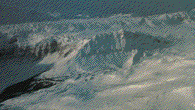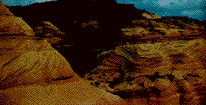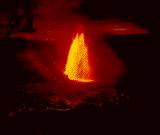Speculated Causes of the Permian Extinction
 Although the cause of the Permian mass extinction remains a debate, numerous theories have been formulated to explain the events of the extinction. One of the most current theories for the mass extinction of the Permian is an agent that has been also held responsible for the Ordovician and Devonian crises, glaciation on Gondwana. A similar glaciation event in the Permian would likely produce mass extinction in the same manner as previous, that is, by a global widespread cooling and/or worldwide lowering of sea level.
Although the cause of the Permian mass extinction remains a debate, numerous theories have been formulated to explain the events of the extinction. One of the most current theories for the mass extinction of the Permian is an agent that has been also held responsible for the Ordovician and Devonian crises, glaciation on Gondwana. A similar glaciation event in the Permian would likely produce mass extinction in the same manner as previous, that is, by a global widespread cooling and/or worldwide lowering of sea level.

The Formation of Pangea
Another theory which explains the mass extinctions of the Permian
is the reduction of shallow continental shelves due to the formation of the super-continent Pangea. Such a reduction in oceanic continental shelves would result in ecological competition for space, perhaps acting as an agent for extinction. However, although this is a viable theory, the formation of Pangea and the ensuing destruction of the continental shelves occurred in the early and middle Permian, and mass extinction did not occur until the late Permian.

Glaciation
A third possible mechanism for the Permian extinction is rapid warming and severe climatic fluctuations produced by concurrent glaciation events on the north and south poles. In temperate zones, there is evidence of significant cooling and drying in the sedimentological record, shown by thick sequences of dune sands and evaporites, while in the polar zones, glaciation was prominent. This caused severe climatic fluctuations around the globe, and is found by sediment record to be representative of when the Permian mass extinction occurred.

Volcanic Eruptions
The fourth and final suggestion that paleontologists have formulated credits the Permian mass extinction as a result of basaltic lava eruptions in Siberia. These volcanic eruptions were large and sent a quantity of sulphates into the atmosphere. Evidence in China supports that these volcanic eruptions may have been silica-rich, and thus explosive, a factor that would have produced large ash clouds around the world. The combination of sulphates in the atmosphere and the ejection of ash clouds may have lowered global climatic conditions. The age of the lava flows has also been dated to the interval in which the Permian mass extinction occurred.
 Click here to view the End-Cretaceous Mass Extinction
Click here to view the End-Cretaceous Mass Extinction
Click here to view Mass Extinctions of the Phanerozoic Menu
Click here to return to the Main Menu
 Click here to view the End-Cretaceous Mass Extinction
Click here to view the End-Cretaceous Mass Extinction